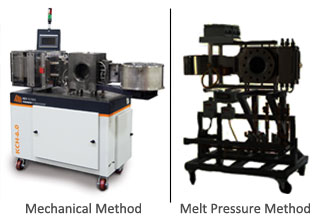

April 23 2019

Continuous Belt Screen Changers are a proven technology to effectively filter contaminates, while maintaining uniform melt pressure in plastic extrusion processes. They achieve this by advancing a ribbon of screen across a breaker plate which continually removes spent screen and introduces fresh screen into the flow to ensure uniform melt pressure over time. Cooling water flows through the screen inlet and outlet assemblies freezing the polymer and forming a plug to provide leak-free operation. When advancing the screen, a portion of the plug from the inlet will be reintroduced into the melt stream and the frozen plug from the outlet will exit the assembly. While this basic operating principle is employed across all styles of continuous belt screen changers, it does not mean they are all created equal. The major differentiator when comparing continuous belt screen changers is the method used to advance the screen. The two basic principles of operation include using melt pressure created by the extruder or using a mechanical method such as a clamp or gear to pull the screen across the breaker plate.
Using melt pressure generated in the extrusion process is the method that usually comes to mind when someone mentions continuous belt screen changers. This method works by using the pressure of molten polymer being processed in combination with the solidified polymer plugs at the screen inlet and outlet to act like a hydraulic cylinder where the screen is the rod, the plugs are the pistons, and the polymer is the working fluid. The outlet chamber, with a larger cross-sectional area than the inlet, is both heated and cooled. To advance the screen, the chamber is heated, the surface of the polymer plug softens to the point where the plug loosens up and extrusion pressure acting on the outlet plug generates enough force to overcome the frictional forces and the corresponding force acting on the inlet plug, thereby advancing the screen. Once the screen has advanced a predetermined distance, the heaters are turned off and cooling water is reintroduced to halt movement and reform the plug.
While there is a design simplicity to this approach, it comes at the cost of significant process complexity that contributes to some unnecessary performance complications. First, the process is very dependent on the material properties of the polymer being processed. If the polymer has a sharp liquid to solid phase transition, such as Polyester (PET), it will result in the plug blowing out of the outlet during the advancement cycle. Thermoplastic elastomers such as TPU do not work in this fashion either as they are not sufficiently rigid to hold a plug during the advancement cycle. Secondly, because the force to advance the screen is derived from the melt pressure, performance of the machine will be dependent on the melt pressure generated in the extrusion process. If it is too low, it may be difficult to generate enough force to advance the screen. If it is too high, the risk of tearing the screen or blowing out the plug during the advance cycle increases. Lastly, the complete screen advancement cycle, including the process of heating up the outlet and plug, advancing the screen, and cooling the outlet to halt screen movement takes approximately fifteen minutes. This inherently makes it slow to react to periods of high contamination and can result in the screen changer being unable to introduce clean screen quickly enough to maintain uniform pressure.
What would be an ideal method of advancing the screen in a continuous belt screen changer that eliminates unnecessary complications?
An alternative to using melt pressure to advance the screen is to use a mechanical means such as a clamp and puller, exactly like the one featured on our KCH continuous belt screen changer. In this process, cooling water is run continuously through the inlet and outlet chambers like the melt pressure advancement method, but the outlet chamber is never heated. The assistance of a clamp and puller will advance fresh screen into the extrusion process, thus eliminating the need to heat the material, and it allows for a significantly smaller screen outlet. This removes the complications of running materials such as PET and thermoplastic elastomers mentioned earlier as you are not relying on the material properties of the polymer to advance the screen. In this method, cycle times can be completed in under thirty seconds and the process is ready for the next cycle in just two minutes, allowing it to quickly react to levels of high contamination. Since the outlet plug is smaller, never heated, and pulled along with the screen, the chance of a plug failure resulting in a leak or blow out is greatly reduced.
While at first pass it may seem that all continuous belt screen changers are created equal, it should now be clear that this is not the case. In today’s market, there are two distinct methods to advance screen – one with much more process flexibility and one that is heavily dependent on the material properties of the polymer being processed. Choosing the right one will have a positive impact on your bottom line.